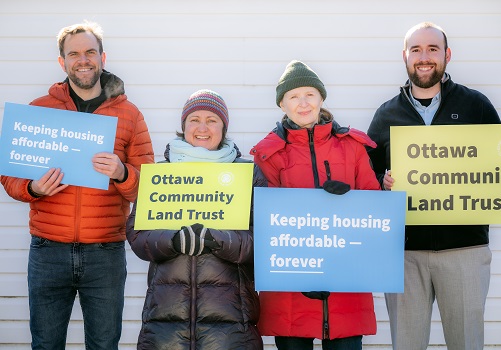Canada’s housing crisis reached an alarming level in 2023, presenting significant challenges for the country. You might wonder, what can we do about it?
The most common response is that we need to increase the supply of homes. According to the latest report from the Canada Mortgage and Housing Corporation (CMHC), almost 3.5 million new units still need to be built by the end of the decade, in addition to what’s already in progress to restore affordability. Often overlooked is that we also need to preserve existing affordable housing. Canada is losing affordable rental units faster than we are building. Between 2011 and 2016, for every new affordable unit created, fifteen existing affordable units were lost.
Both of these are absolutely true. However, in order to truly address the housing crisis in Canada, we need to address the elephant in the room, the financialization of housing: treating homes as commodities and investment vehicles, rather than as a human right. Real estate is Canada’s largest industry, making up 20% of total GDP. But most of this is not building new homes (which we desperately need), but in speculative real estate transactions (buying and selling of existing properties at inflated rates). This has driven the average price of a residential home in Canada to increase by 200% in the last 20 years.
Ottawa Community Land Trust (OCLT) is a non-profit devoted to preserving and increasing affordable housing in Ottawa. Photo credit: Ashley Fraser
Community Land Trusts is gaining momentum
Non-profit and co-operative housing (non-market housing) is the viable alternative. But we have stopped building it. Between 1973 and 1994, Canada was averaging around 16,000 non-profit or co-op homes built or acquired every year. Since then, the number has dropped to just 1,500 homes a year. Now, more than ever, we need to urgently increase the supply and preserve existing non-market housing. The good news is, in the absence of a coordinated response at the government level, community-led organizations are coming together to take matters into their own hands.
One transformative solution gaining momentum is the growing movement of Community Land Trusts (CLTs). These are non-profits that acquire land within a given neighborhood and keep it affordable and accessible for everyone in the community – in perpetuity. This model gives stability to longtime renters, especially in areas facing the threat of displacement, gentrification, and “renoviction.”
CLTs have been around since 1969, when they were first established in the southern USA by grassroots civil rights activists to secure greater economic and political independence for African-American farmers. Community Land Trusts are already making a profound impact in Canada and there are now more than 40 CLTs across the country, supported by the growing Canadian CLT Network. Together they have preserved more than 10,000 affordable residential units, and this number is expected to grow by 25% by the end of 2024. By securing and preserving affordable housing, CLTs break down barriers to social mobility, providing a foundation for individuals and families to thrive. Through democratic governance and community ownership, community members become stakeholders in their housing.
CLTs at work
Some examples of the incredible work of CLTs include: Parkdale Neighbourhood Land Trust and its charitable arm, The Neighbourhood Land Trust, who have built an impressive housing portfolio of 205 rental units and 85 single family homes worth approximately $85 million. In Vancouver, Hogan’s Alley Land Trust is working to protect Hogan’s Alley Block and provide affordable housing, social enterprise spaces, and cultural amenities that will represent the legacy of Strathcona’s Black community.
This also includes preserving Nora Hendrix Place, a 52-home social housing development that prioritizes Indigenous and Black people who are at risk of, or currently homeless. Kensington Market Community Land Trust is preserving affordable housing in their community that is facing tremendous gentrification and eviction pressure. In the last 2 years they have secured 12 residential units and 5 commercial units, with many other plans in the works. But it is certainly no easy task.
Funding is a challenge
The biggest challenge facing all Community Land Trusts is financing. Funds are desperately needed to support land acquisition, housing development, and operations. The National Census points out that most CLTs are either unfunded or have capital that will only last until early 2024. Another constraint in scaling this model across Canada is the lack of government funding for property acquisition or new development – most often they require support from municipal governments, CMHC programs, and donations or fundraisers to fund new projects.
A sustainable source of capital is a necessity for CLTs to be successful. And while they don’t always have that, what they do have is a ton of community support. Tapestry Community Capital is a non-profit that exists to democratize access to capital for these organizations: turning social capital into financial capital. By allowing everyday people to invest directly into non-profits, charities, and co-operatives with community bonds. This is an ideal, and values-aligned financing solution for CLTs and other non-market housing developers.
Community is key
As part of CMHC’s Housing Supply Challenge, Tapestry is working with the Kensington Market CLT and Ottawa CLT with the goal to help meet Canada’s pressing need for safe and affordable homes by breaking down barriers to the creation and preservation of housing supply. With Tapestry’s solution, the two CLTs will innovatively mobilize their community of supporters to raise investment with community bonds to fill in the financing gap.
Raising capital through community bonds allows them to access financing on their own terms and aligns with their ethos of true community economic development. This means financial returns of investing go back to everyday people living in the community, instead of big financial institutions, which builds community wealth.
It is clear that to meaningfully address the housing crisis, simply building more homes is not the answer. We need to take active steps towards addressing the financialization of housing by building and preserving non-market housing. Community Land Trusts funded by local investment are a rapidly growing solution that get to the heart of the problem. And as a community, we need to support and help scale this model.
Ryan Collins-Swartz is the co-executive director at Tapestry Community Capital


